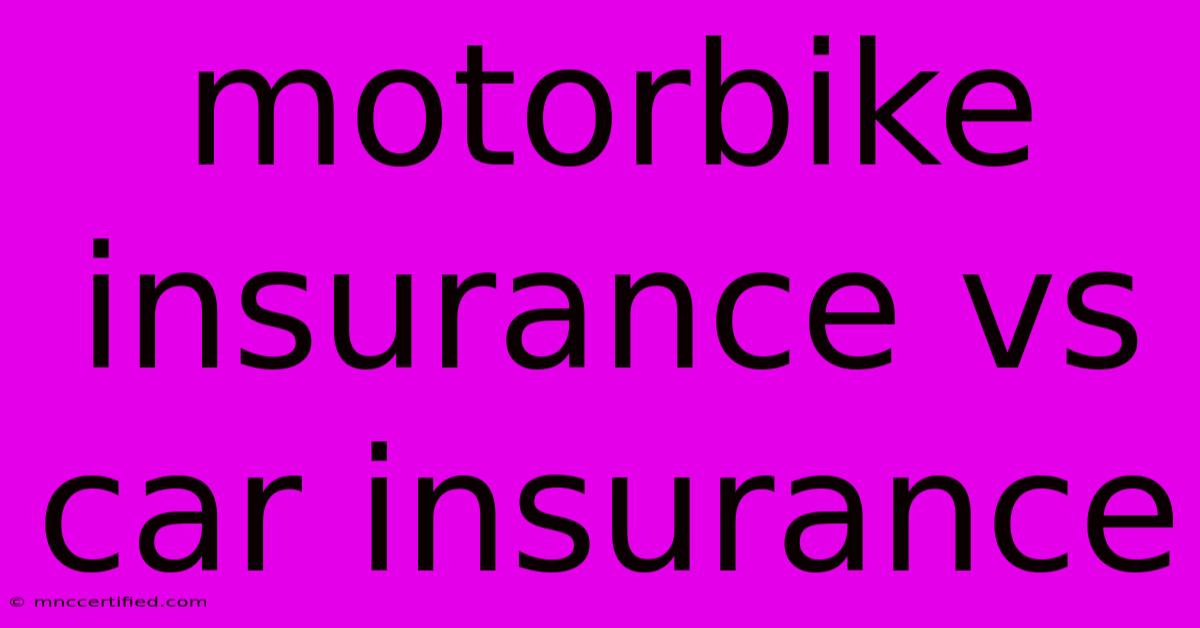Motorbike Insurance Vs Car Insurance

Table of Contents
Motorbike Insurance vs. Car Insurance: What's the Difference?
Choosing the right insurance for your vehicle is crucial, especially when you're considering a motorbike. While both car and motorbike insurance provide financial protection, they differ significantly in terms of coverage, costs, and factors influencing premiums. This guide will delve into the key differences, helping you understand the nuances of each type of insurance and make an informed decision.
Key Differences: A Side-by-Side Comparison
| Feature | Motorbike Insurance | Car Insurance |
|---|---|---|
| Coverage Types | Third Party Only (TPO), Third Party Fire and Theft (TPFT), Comprehensive | Third Party Only (TPO), Third Party Fire and Theft (TPFT), Comprehensive |
| Cost | Typically cheaper than car insurance due to lower repair costs | Generally more expensive than motorbike insurance |
| Factors Influencing Premium | Bike value, engine size, rider age, riding experience, location, modifications, safety features | Car value, engine size, driver age, driving experience, location, safety features, vehicle history |
| Liability Coverage | Covers damage to third parties and their property | Covers damage to third parties and their property |
| Own Damage Coverage | Only available with Comprehensive policies | Available with Comprehensive policies |
| Personal Accident Coverage | Often included in Comprehensive policies | Typically optional |
| Theft Coverage | Available with TPFT and Comprehensive policies | Available with TPFT and Comprehensive policies |
| Risk Factors | Higher risk of accidents and theft compared to cars | Generally considered lower risk than motorbikes |
Understanding the Coverage Types
Third Party Only (TPO): This basic level covers only damage caused to third parties and their property by your motorbike. It doesn't cover your own bike or injuries to yourself.
Third Party Fire and Theft (TPFT): This offers additional coverage for damage caused to your motorbike by fire or theft, alongside third-party liability.
Comprehensive: This is the most comprehensive type of insurance. It covers damage to your bike, including accidental damage, fire, theft, and vandalism, as well as third-party liability. It often includes personal accident coverage for the rider.
Cost Considerations: Why Motorbike Insurance is Often Cheaper
Motorbike insurance premiums are usually lower than car insurance due to several factors:
- Lower Repair Costs: Repairing a damaged motorbike typically costs less than repairing a car.
- Lower Theft Risk: While theft can be a concern, motorbikes are generally less prone to theft than cars.
- Reduced Mileage: Motorbikes are often used for shorter distances, which means they are on the road less, decreasing potential accident risk.
Choosing the Right Insurance for You
The best motorbike insurance policy depends on your individual circumstances and risk appetite.
- If you're on a budget, Third Party Only (TPO) may be sufficient.
- For additional peace of mind, consider Third Party Fire and Theft (TPFT).
- If you want comprehensive coverage, opt for Comprehensive insurance.
Other important factors to consider include:
- Your riding experience and safety record.
- The value of your motorbike.
- Your budget.
It's always recommended to compare quotes from different insurance providers before making a decision. This will help you find the best value for your money.
Off-page SEO strategies for this article:
- Backlinking: Reach out to motorcycle forums and blogs to request a link back to this article from a relevant page.
- Social Media: Share this article on social media platforms where your target audience is active, using relevant hashtags.
- Guest Posting: Write a guest post for a related website, including a link back to this article.
By understanding the key differences between motorbike and car insurance, you can choose the right policy to protect yourself and your vehicle while on the road. Remember to compare quotes, carefully consider your needs, and choose the level of coverage that aligns with your budget and risk tolerance.

Thank you for visiting our website wich cover about Motorbike Insurance Vs Car Insurance. We hope the information provided has been useful to you. Feel free to contact us if you have any questions or need further assistance. See you next time and dont miss to bookmark.
Featured Posts
-
Starmer Macron To Show European Unity On Armistice Day
Nov 11, 2024
-
Is Cryptex Finance A Good Investment
Nov 11, 2024
-
French Tv Remembering Armistice Day
Nov 11, 2024
-
Joey Bosa Hip Cleared For Week 10
Nov 11, 2024
-
Scotland Vs South Africa Result And Reaction
Nov 11, 2024